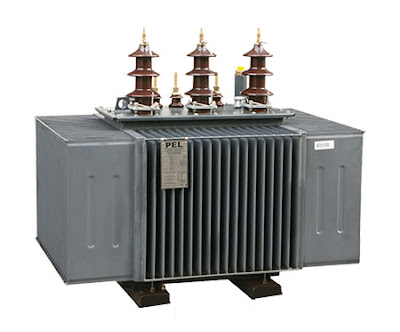Do You Know The Difference between Power Transformer and Distribution Transformer?
Date: 2017-03-10 Clicked: 4538
Difference between Power Transformer and Distribution Transformer
The main and basic difference between a Power transformer and a Distribution Transformer is that Power transformers are used in transmission network of higher voltages for step-up and step down application like 400 kV, 200 kV, 110 kV, 66 kV, 33kV and are generally rated above 200 MVA.
Distribution transformers are used for lower voltage distribution networks as a mean for end user connectivity. 11 kV, 6.6 kV, 3.3 kV, 440 V, 230 V and are generally rated less than 200 MVA.
On the basis of Transformer Size / Insulation Level,
Power transformer is used for the transmission purpose at heavy load, high voltage greater than 33 KV and 100% efficiency. It also having a big in size as compare to distribution transformer, it used in generating station and Transmission substation at high insulation level.
The distribution transformer is used for the distribution of electrical energy at low voltage as less than 33 kV in industrial purpose and 440 – 220 V in domestic purpose. It work at low efficiency at 50-70%, small size, easy in installation, having low magnetic losses & it is not always fully loaded.
On the basis of Iron Losses and Copper Losses,
Power Transformers are used in Transmission network so they do not directly connect to the consumers, so load fluctuations are very less. These are loaded fully during 24 hours a day, so copper losses and Iron losses takes place throughout day.
The average loads are nearer to full loaded or full load and these are designed in such a way that maximum efficiency occur at full load condition.
Distribution Transformers are used in Distribution Network so directly connected to the consumer so load fluctuations are very high. Distribution Transformers are not loaded fully at all time so iron losses takes place 24 hr a day and copper losses takes place based on load cycle. The specific weight i.e. (iron weight)/(cu weight) is more. Average loads are about only 75% of full load and these are designed in such a way that maximum efficiency occurs at 75% of full load.
As these are time dependent therefore All Day Efficiency is defined in order to calculate the efficiency.
Power Transformers are used for transmission as a step up devices so that the I2rloss can be minimized for a given power flow. These transformers are designed to utilize the core to maximum and will operate very much near to the knee point of B-H curve. This brings down the mass of the core enormously.
Naturally these transformers have the matched iron losses and copper losses at peak load i.e. the maximum efficiency point where both the losses match.
Distribution transformers obviously cannot be designed like this. Hence the All-Day-Efficiency comes into picture while designing it. It depends on the typical load cycle for which it has to supply. Definitely Core design will be done to take care of peak load and as well as all-day-efficiency. It is a bargain between these two points.
Power transformer generally operated at full load. Hence, it is designed such that copper losses are minimal. However, a distribution transformer is always online and operated at loads less than full load for most of time. Hence, it is designed such that core losses are minimal.
In Power Transformer the flux density is higher than the distribution transformer.
On the basis of Maximum Efficiency,
The main difference between Power and Distribution Transformer is that Distribution Transformer is designed for maximum efficiency at 60% to 70% load as normally doesn’t operate at full load all the time. Its load depends on distribution demand. Whereas power transformer is designed for maximum efficiency at 100% load as it always runs at 100% load being near to generating station.
Distribution Transformer is used at the distribution level where voltages tend to be lower .The secondary voltage is almost always the voltage delivered to the end consumer. Because of voltage drop limitations, it is usually not possible to deliver that secondary voltage over great distances.
As a result, most distribution systems tend to involve many clusters of loads fed from distribution transformers, and this in turn means that the thermal rating of distribution transformers doesn’t have to be very high to support the loads that they have to serve.
All Day Efficiency = (Output in KWhr) / (Input in KWhr) in 24 hrs which is always less than power efficiency.
COMPANY SHOW:
Guan Tong is a key player in electric and telecom industry. We manufacture and OEM transmission, distribution and telecommunication hardware and fittings.The innovative spirit in our enterprise makes us not only the best one, but the first one in the section.
















 Claire
Claire  Sales
Sales  Enquiry
Enquiry